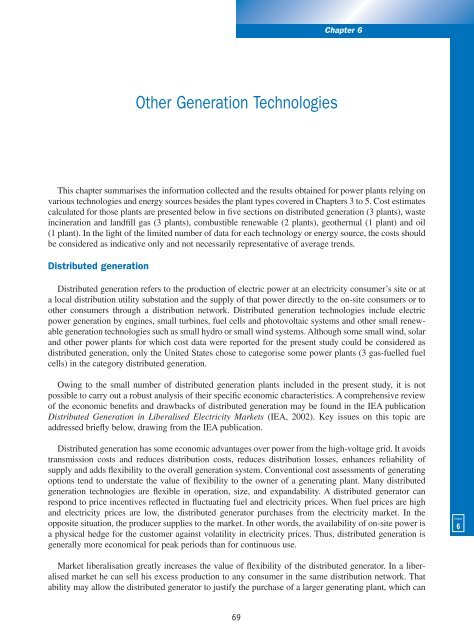Projected Costs of Generating Electricity - OECD Nuclear Energy ...
Projected Costs of Generating Electricity - OECD Nuclear Energy ...
Projected Costs of Generating Electricity - OECD Nuclear Energy ...
You also want an ePaper? Increase the reach of your titles
YUMPU automatically turns print PDFs into web optimized ePapers that Google loves.
Chapter 6<br />
Other Generation Technologies<br />
This chapter summarises the information collected and the results obtained for power plants relying on<br />
various technologies and energy sources besides the plant types covered in Chapters 3 to 5. Cost estimates<br />
calculated for those plants are presented below in five sections on distributed generation (3 plants), waste<br />
incineration and landfill gas (3 plants), combustible renewable (2 plants), geothermal (1 plant) and oil<br />
(1 plant). In the light <strong>of</strong> the limited number <strong>of</strong> data for each technology or energy source, the costs should<br />
be considered as indicative only and not necessarily representative <strong>of</strong> average trends.<br />
Distributed generation<br />
Distributed generation refers to the production <strong>of</strong> electric power at an electricity consumer’s site or at<br />
a local distribution utility substation and the supply <strong>of</strong> that power directly to the on-site consumers or to<br />
other consumers through a distribution network. Distributed generation technologies include electric<br />
power generation by engines, small turbines, fuel cells and photovoltaic systems and other small renewable<br />
generation technologies such as small hydro or small wind systems. Although some small wind, solar<br />
and other power plants for which cost data were reported for the present study could be considered as<br />
distributed generation, only the United States chose to categorise some power plants (3 gas-fuelled fuel<br />
cells) in the category distributed generation.<br />
Owing to the small number <strong>of</strong> distributed generation plants included in the present study, it is not<br />
possible to carry out a robust analysis <strong>of</strong> their specific economic characteristics. A comprehensive review<br />
<strong>of</strong> the economic benefits and drawbacks <strong>of</strong> distributed generation may be found in the IEA publication<br />
Distributed Generation in Liberalised <strong>Electricity</strong> Markets (IEA, 2002). Key issues on this topic are<br />
addressed briefly below, drawing from the IEA publication.<br />
Distributed generation has some economic advantages over power from the high-voltage grid. It avoids<br />
transmission costs and reduces distribution costs, reduces distribution losses, enhances reliability <strong>of</strong><br />
supply and adds flexibility to the overall generation system. Conventional cost assessments <strong>of</strong> generating<br />
options tend to understate the value <strong>of</strong> flexibility to the owner <strong>of</strong> a generating plant. Many distributed<br />
generation technologies are flexible in operation, size, and expandability. A distributed generator can<br />
respond to price incentives reflected in fluctuating fuel and electricity prices. When fuel prices are high<br />
and electricity prices are low, the distributed generator purchases from the electricity market. In the<br />
opposite situation, the producer supplies to the market. In other words, the availability <strong>of</strong> on-site power is<br />
a physical hedge for the customer against volatility in electricity prices. Thus, distributed generation is<br />
generally more economical for peak periods than for continuous use.<br />
Chapter<br />
6<br />
Market liberalisation greatly increases the value <strong>of</strong> flexibility <strong>of</strong> the distributed generator. In a liberalised<br />
market he can sell his excess production to any consumer in the same distribution network. That<br />
ability may allow the distributed generator to justify the purchase <strong>of</strong> a larger generating plant, which can<br />
69

















